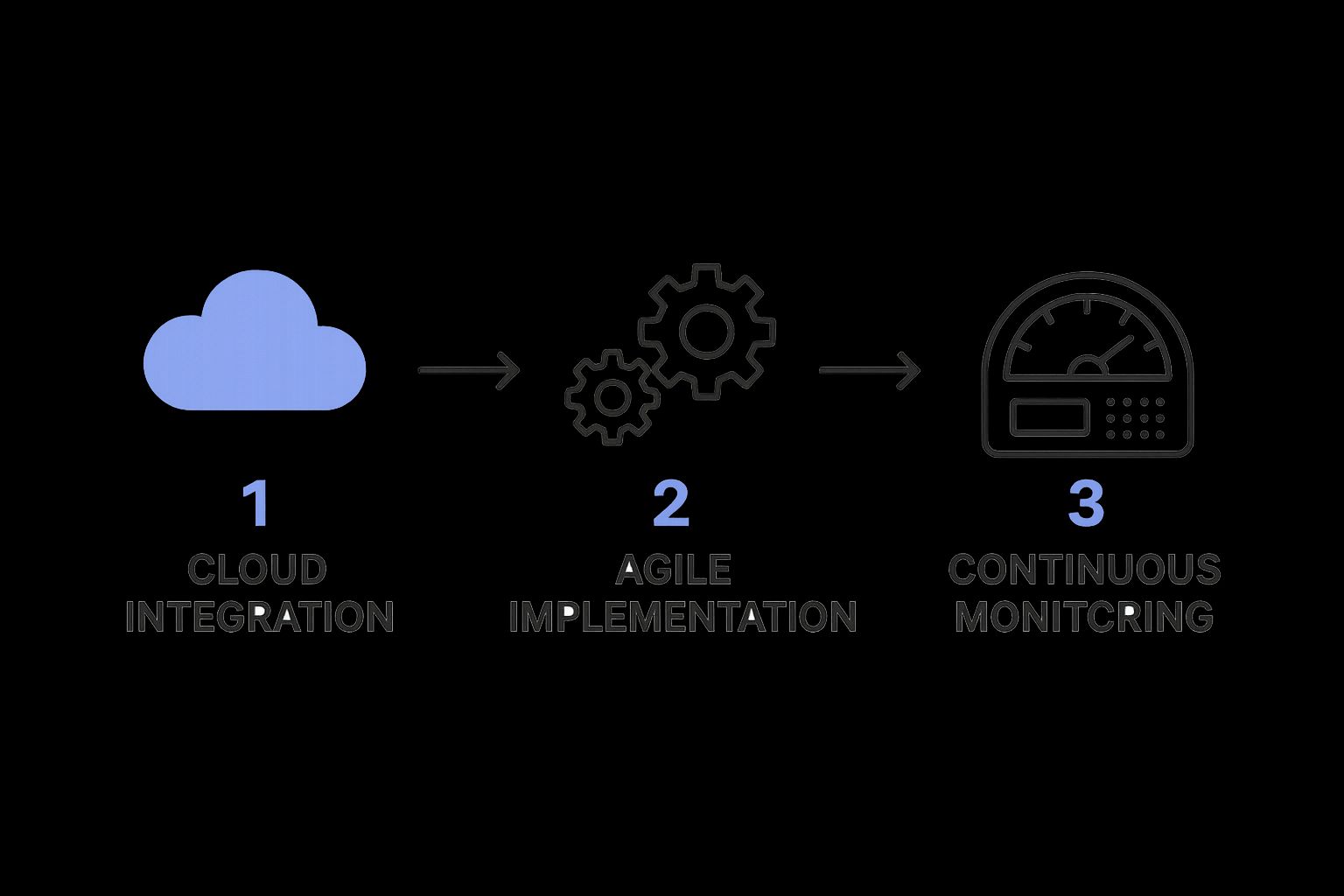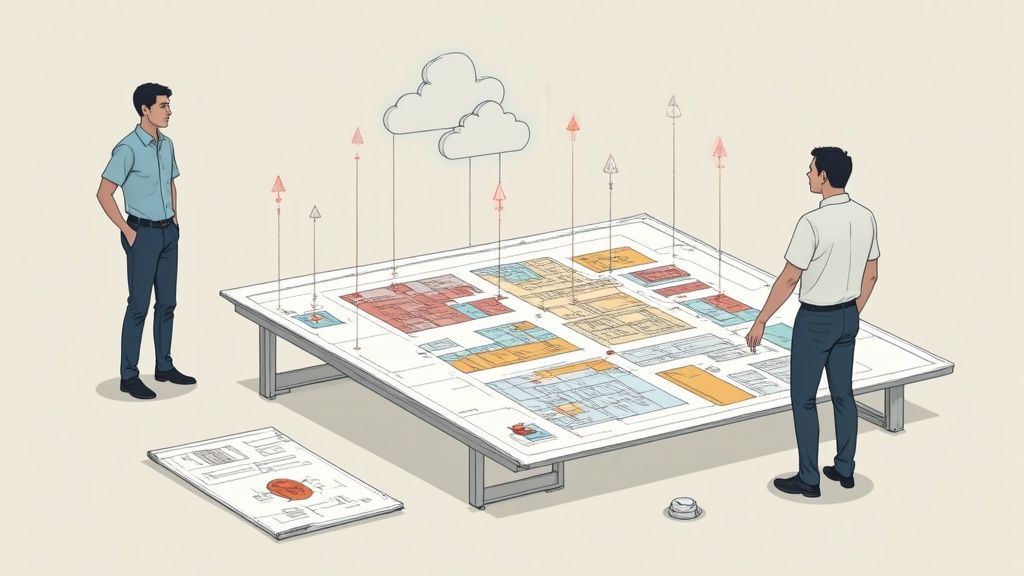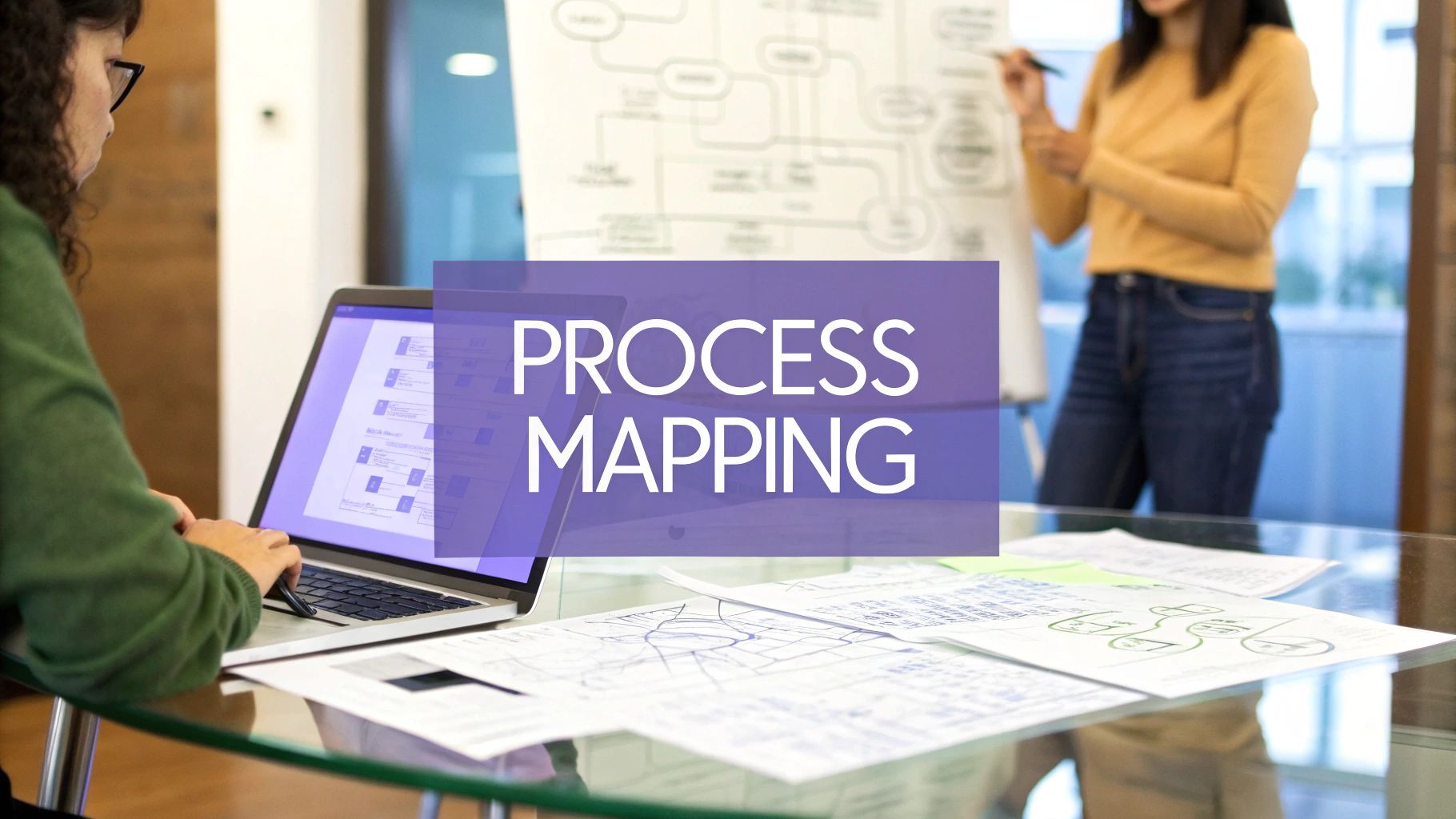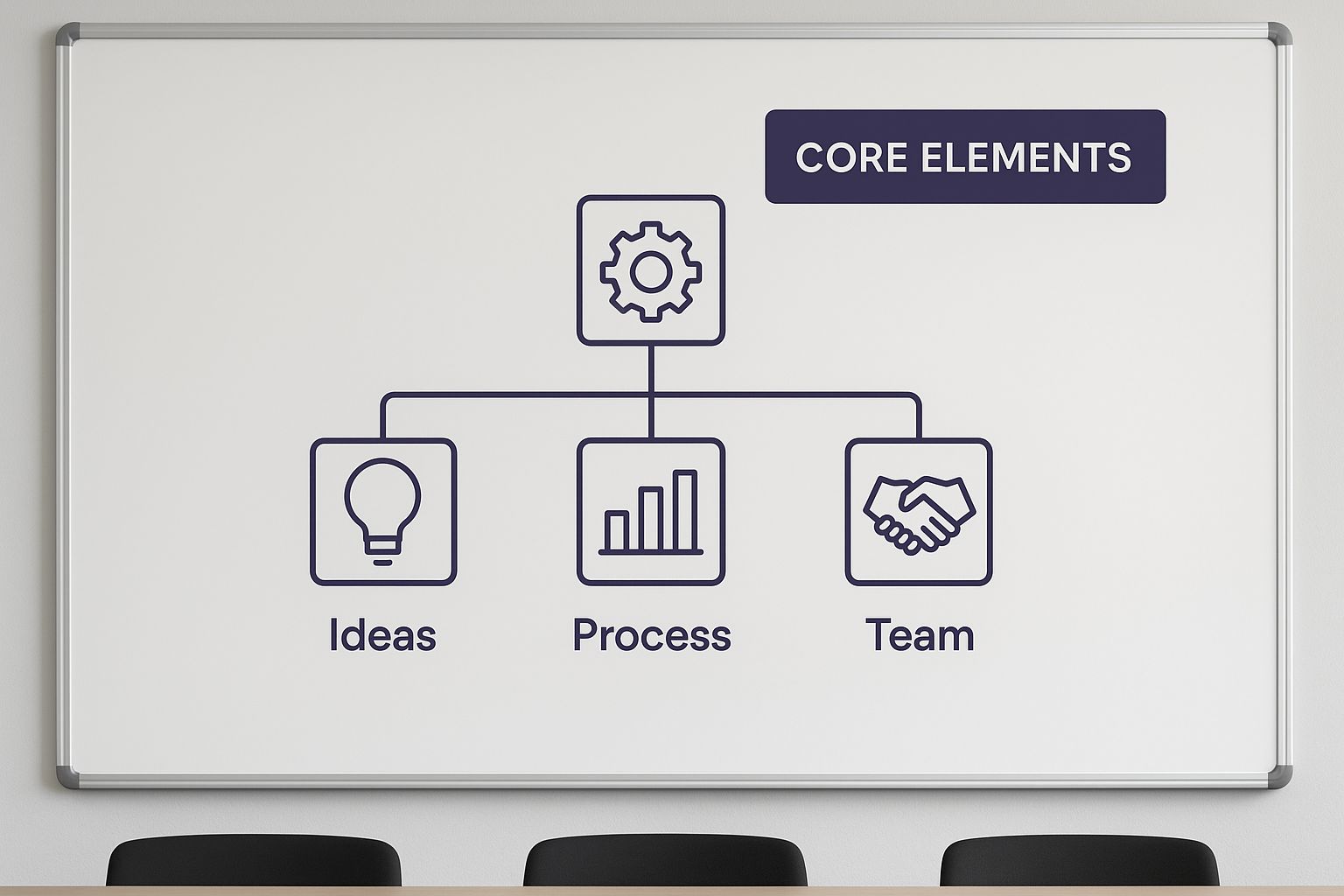When people talk about digital transformation consulting, it's easy to think it's all about plugging in new technology. That’s not the full story. True transformation is a strategic partnership to modernise your organisation by aligning your people, processes, and technology.
What Are Digital Transformation Consulting Services?

Think of it like renovating a house. You wouldn't just scatter a few smart speakers around and call it modern. You'd rethink the layout, update the plumbing, and rewire the electrics to create a space that genuinely works for the people living there. That’s the real essence of digital transformation consulting services. It’s a methodical way of making your business work better from the inside out.
We’ve learned that real, lasting change starts with understanding your team's day-to-day challenges first. This people-first approach is the only way to cut through the operational fog that holds businesses back. It ensures any new system actually serves your core goals. It’s about building a more open, capable, and operationally sustainable organisation.
It's More Than Just Installing Software
Too often, "transformation" is misunderstood as a simple tech project. A consultant might suggest a new software platform, manage the installation, and then disappear. This rarely sticks because it overlooks the human side of the equation. True transformation consulting looks at the whole picture.
It starts by asking the right questions.
- How do your teams really work, and where are the frustrating bottlenecks?.
- What manual, repetitive tasks are draining their time and enthusiasm?.
- Are your current systems talking to each other, or are they creating digital silos?.
- Does your leadership team have the clear, unified data needed for sharp decisions?.
By starting with people and process, we make sure technology becomes an enabler, not just another tool to juggle.
The goal isn't just to install new software. It's to embed a new way of working that frees up your team's time, improves collaboration, and builds lasting capability inside your organisation.
A good consultant breaks down a digital transformation project into clear, manageable components. This helps everyone understand the path from strategy to execution.
Core Components of Digital Transformation Consulting
This structured approach ensures that every aspect of the transformation is aligned, from high-level strategy to the practical details of implementation.
The Strategic Value and Market Growth
The demand for this strategic guidance is growing. It's a direct response to a world that demands better operational efficiency and smarter, faster decisions. The global market for these services was valued at around USD 53.3 billion in 2024 and is set to grow significantly. This momentum shows how vital it is for UK organisations to weave advanced tech like cloud computing and data analytics into their very fabric. You can explore more details on the digital transformation market growth for a deeper dive.
A great consulting partner acts as a copilot, not a backseat driver. They bring an outside perspective to spot hidden inefficiencies and help you build a clear, no-nonsense roadmap. The outcome isn't a glossy slide deck. It’s a tangible plan with scoped pricing and defined deliverables that lead to real, measurable improvements.
Ultimately, this service is about building digital sovereignty. It gives your organisation the ability to own and manage its digital future with confidence. This keeps the capability inside your business, where it belongs, creating a sustainable impact long after the project is finished.
Why UK Businesses Invest in Digital Transformation
Across the UK, leaders are no longer just talking about transformation. They're acting. This isn’t a vague trend. It’s a direct answer to a competitive world that demands sharper decision-making, smarter cost management, and greater operational efficiency. The pressure to modernise isn't just for large corporations. Small and mid-sized businesses now see it as a core strategic priority.
The push for change comes from all directions. Internally, leaders want to free teams from manual tasks and disconnected systems. Externally, evolving customer expectations and sustainability goals are forcing the issue.
A Response to Economic and Market Pressures
Uncertain economic times demand businesses to be more resilient and agile. Bringing in digital transformation consultants is a proactive move to build that resilience. By improving internal processes and using data more effectively, organisations can make better strategic bets and navigate uncertainty with more confidence. The aim is to create a leaner operation that can handle whatever the economy throws at it.
This isn't just about survival. It's about grabbing a clear market opportunity. The UK's digital transformation market was valued at around USD 61.82 billion in 2025. Projections show this figure is expected to almost double to roughly USD 123.79 billion by 2030. You can read more about the UK's transformation market growth to grasp the scale of this shift.
Beyond Efficiency to Tangible Outcomes
While efficiency is a massive driver, the real reasons for investing run deeper. Leaders are chasing tangible, sustainable results that make the whole organisation stronger. The goal is to build a business that's not just more profitable but is also a better place to work.
Here are the key drivers we see time and again.
- Reclaiming Team Time. Automating repetitive jobs and smoothing workflows gives your skilled people the freedom to focus on high-value work.
- Fostering Better Collaboration. When you break down information silos with integrated systems, you create the kind of collective intelligence that sparks sharper, faster decisions.
- Building a Resilient Organisation. Modernised operations and an adaptable culture create a business that can react effectively to new challenges and opportunities.
This is especially true for organisations in critical sectors like healthcare and public services. They are undertaking digital upgrades not just for efficiency's sake, but to meet new standards of service and care.
The core reason to invest is simple: to build an organisation that is more open, capable, and operationally sustainable. It's about ensuring the business can not only compete today but also adapt and thrive for years to come.
Thinking through these drivers clarifies the "why" behind any project. Having a clear vision is the first step in developing effective digital transformation strategies that deliver genuine, lasting impact. The focus must always be on achieving measurable results that matter to your people and your mission.
Our People-First Transformation Framework

Ask most consultancies about digital transformation, and they’ll launch straight into a pitch about technology. We think that’s backwards. A new platform is useless if it doesn't solve a real problem for the people using it every day. That's why our digital transformation consulting services always start—and end—with your people.
Our entire approach is built on a simple idea. We need to understand your team's reality first. Their workflows, their frustrations, their workarounds. We have to map out how things really work before we can think about new tools. It's only by getting to the 'why' behind the challenges that we can design a 'what' that actually makes a difference.
The Copilot Model in Action
This isn't about us swooping in and telling you what to do. We call it a copilot model for a reason. We work with you, not just for you. Think of us as part of your crew, sitting alongside you. This close partnership is the bedrock of our work, ensuring every decision is made together and every solution is fit for purpose.
It’s a hands-on, collaborative way of working that builds shared ownership right from the start. We deliberately avoid the classic consulting pitfall, where an external team drops a 100-page slide deck on your desk and disappears. We stick with you, from the first conversation to the final handover.
The Three Core Stages of Transformation
To make the journey less overwhelming, we break every project down into three clear stages. This demystifies the process, gives us clear milestones, and keeps everyone on the same page.
- Discovery. This is our immersion phase. We roll up our sleeves and get into your world. Through workshops and one-on-one chats, we map your current operations, pinpoint the real blockers, and dig until we find the root causes of friction.
- Design. Armed with insights from Discovery, we sit down with your team to design the future state. This isn't a theoretical exercise. It's a practical process where we co-create new ways of working and define the technology needed to make them a reality. Your team's input here is non-negotiable.
- Delivery. This is where the plan comes to life. We manage the implementation, whether that’s setting up a new system or re-engineering a core business process. Critically, this stage is heavy on training and support to make sure your team feels confident and ready to take the reins.
This staged approach moves us smoothly from understanding the problem to designing the fix and making it stick.
We don’t just implement technology. We embed new ways of working. Our goal is to build collective intelligence that travels across your organisation, creating a permanent uplift in capability.
A Commitment to Digital Sovereignty
We believe deeply in digital sovereignty. In plain English, our main goal is to make ourselves redundant. We aren’t here to create a long-term dependency on Yopla. Our mission is to leave the skills, ownership, and confidence to manage your new systems squarely with your team.
When we're finished, your people don't just have a new tool. They have the know-how to use it, adapt it, and keep improving it long after we’re gone. That's how we deliver a sustainable impact that strengthens your business. As part of this, we provide a clear plan for overcoming resistance to change.
Transparency in Process and Price
Underpinning this framework is a commitment to total transparency. No surprise invoices. No getting lost in a project with no end in sight.
Our Plans Portal gives you a single source of truth for every task, milestone, and document, so you're always in control. Unlike consultancies that use opaque hourly billing, we use fixed, scoped pricing for each stage. You'll always know exactly what you’re getting, what it costs, and the outcome it will deliver.
The End-to-End Consulting Process Explained
What does a transformation project actually look like? It's a fair question. We believe in demystifying the process, breaking it down into a structured plan with clear milestones and defined results. This isn't a vague 'journey' into the unknown. It's a project with a definite start, middle, and end.
Everything begins with a simple scoping call. This is our chance to listen, get to grips with your goals, and start seeing the world from your perspective. It’s the first step in building a genuine partnership.
The Initial Discovery and Audit
After that initial chat, we move into a hands-on Discovery Workshop & Audit. This is where we work directly alongside your team to map your current reality. We don't just look at system diagrams. We talk to the people who do the work every day, uncovering the real-world friction points and time-sapping workarounds that drain energy.
The aim here is to establish a shared, honest starting point. What's working well? What's causing the most headaches? Where are the hidden chances for quick wins? We document all of this to create a clear picture that everyone in your organisation can agree on.
Strategy, Roadmap, and Phased Implementation
With an understanding of your current state, we then co-create a practical Strategy & Roadmap. This isn't a dense document destined to gather dust. It's a clear, actionable plan that outlines the 'what', 'why', and 'how' of the change, complete with defined deliverables and scoped pricing for each stage. We make sure our framework for people-first change is baked into the core of this plan.
From there, implementation is a phased, collaborative process. We act as a copilot with your team, introducing changes in manageable chunks to avoid overwhelming people. This approach lets us gather constant feedback and make tweaks along the way, ensuring the final solution is perfectly tuned to how your business runs.
The core of our delivery model is co-creation. We build with your team, not just for them. This ensures the final solution is not only technically sound but also enthusiastically adopted because your people helped shape it.
The following infographic gives a good sense of the core flow, showing how we move from integrating foundational systems to fostering continuous improvement.

This visualises how we connect cloud-based tools with agile ways of working and constant monitoring to deliver results that stick.
Building Capability and Ensuring a Seamless Handover
The final stages are the most critical for delivering long-term value. As we put changes in place, we provide dedicated Team Training & Capability Building. Our goal isn’t just to hand over a new tool. It’s to make sure your people feel confident and empowered to use it. We build skills from within.
Finally, we carry out a seamless Handover & Continuous Improvement plan. This is where we deliver on our commitment to your digital sovereignty.
The key steps in this final phase include the following.
- Complete Knowledge Transfer. We make sure your team has all the documentation and training they need to truly own the new systems and processes.
- Establishing Internal Champions. We identify and empower key people within your team to become the go-to experts who can lead future improvements.
- Setting Up Monitoring. We create simple dashboards and feedback loops so you can easily track performance and spot new opportunities.
Our copilot model means we're right there with you at every stage, not just shouting advice from the sidelines. The result is a transformation that is truly embedded in your organisation, leaving you stronger and more capable than when we started.
How to Choose the Right Transformation Partner

Picking a partner for your transformation is one of the most important decisions you’ll make. Get it right, and you fast-track progress, build real internal capability, and see a powerful return on investment. Get it wrong, and you face stalled projects, wasted money, and a demoralised team.
The market for digital transformation consulting services is buzzing. The UK consulting market has shown impressive growth, with forecasts for 2025 hovering between 6.4% and 8.7%. This isn't surprising, given the intense demand from businesses needing guidance on everything from AI to streamlining operations.
With so many firms out there, how do you find a genuine partner? It comes down to asking the right questions.
Look for a People-First Mindset
Here’s a simple test. Does a potential partner lead with questions about technology stacks? Or do they start by asking about your people, their daily frustrations, and the real-world bottlenecks in your workflows? This is the clearest sign of whether you’re talking to a technology reseller or a true transformation consultant.
A real partner gets that systems are there to serve people, not the other way around. They’ll put in the time upfront to map your processes and talk to your team to uncover the root causes of inefficiency. They know from experience that even the best software is doomed to fail if it doesn’t solve a real human problem.
Scrutinise the Commercial Model
The old consulting model often runs on opaque, hourly billing. This creates a conflict of interest. The incentive is to stretch out the engagement, not to deliver results efficiently.
A modern partner offers a transparent alternative. Look for these signs.
- Scoped pricing. Clear, fixed costs for well-defined stages of work.
- Defined deliverables. You should know exactly what you're paying for and what you'll get.
- No surprise invoices. This gives you budget clarity and control from day one.
This model aligns their success directly with yours. Their focus shifts from billing hours to delivering tangible, agreed-upon value.
Your partner should feel like an extension of your own team, not an external vendor. Their success ought to be tied directly to yours, with a shared commitment to building your organisation’s long-term strength.
Focus on Digital Sovereignty
Perhaps the most critical question to ask is this: "What’s your plan to make yourselves redundant?". The goal of any good digital transformation consulting services engagement shouldn't be to create a permanent dependency. It should be to build your own internal capability.
We call this digital sovereignty. It’s the idea that the skills, knowledge, and ownership of your new systems must stay within your organisation. The right partner acts as a copilot, working side-by-side with your team to transfer knowledge and build their confidence. They will have a clear plan for the handover, empowering your people to manage and evolve the new ways of working long after the project ends. This focus is vital for overcoming resistance and ensuring genuine adoption.
Choosing the right partner comes down to understanding their fundamental approach. Do they sell solutions, or do they build capability? The table below highlights the key differences.
Choosing Your Consulting Partner: A Comparison
By contrasting these different approaches, you can spot the firms that are genuinely committed to your sustainable, long-term success.
Your Digital Transformation Questions Answered
Even when everyone agrees that change is needed, it’s natural to have questions before starting a project. Leaders often share similar concerns about cost, time, and what happens when the project is over. Here are some candid answers to the questions we hear most often.
How Much Do Digital Transformation Consulting Services Cost?
This is often the first question, and the honest answer is: it depends on the scope. That said, we disagree with the traditional consultancy model of opaque, open-ended hourly billing.
We believe in being completely upfront. For every project, we provide fixed, scoped pricing for each distinct stage. This means you know the exact investment required for a clear set of deliverables before we start. It gives you total budget clarity and ensures our focus stays on delivering value, not watching the clock.
How Do We Measure the ROI of a Transformation Project?
Measuring the return on your investment goes beyond simple financial figures. At the start, we work with you to define what success looks like for your organisation. Success is about the lasting, sustainable impact on your business.
This often includes quantifiable gains such as the following.
- Reduced operational costs and less manual work.
- Freed-up team time that can be reinvested into strategic work.
- Faster, sharper decision-making cycles.
- An improvement in employee engagement and morale.
You can get a deeper insight by reading about how to measure digital transformation. The real ROI is becoming a more capable, resilient, and efficient organisation.
Will Our Team Be Able to Manage the New Technology?
Absolutely. That's the whole point. Our philosophy of digital sovereignty is at the core of how we operate. We’re not here to create dependency. We're here to build your internal strength.
Our copilot approach means we work side-by-side with your team throughout the project. We embed knowledge and build skills as we go. We don't just parachute in, implement a platform, and disappear. We make sure your people are confident and capable of owning, managing, and evolving the new systems themselves.
Our main goal is to make ourselves redundant. We succeed when we leave you with a lasting, in-house capability.
How Much Time Will This Require from Our Team?
We get it. You have a business to run. Our entire process is designed to be efficient and to respect your team’s time. We structure workshops and check-ins strategically, aiming to get the most valuable input while causing the least disruption.
By using collaborative tools like our Plans Portal, we keep everyone informed without an endless parade of meetings. An initial time investment from your key people is crucial, of course. But that investment pays off by ensuring the final solution is one your team genuinely understands, adopts, and values.
If you’re ready to cut through the operational fog and build a more capable organisation, we’re ready to help.
Let’s Talk








